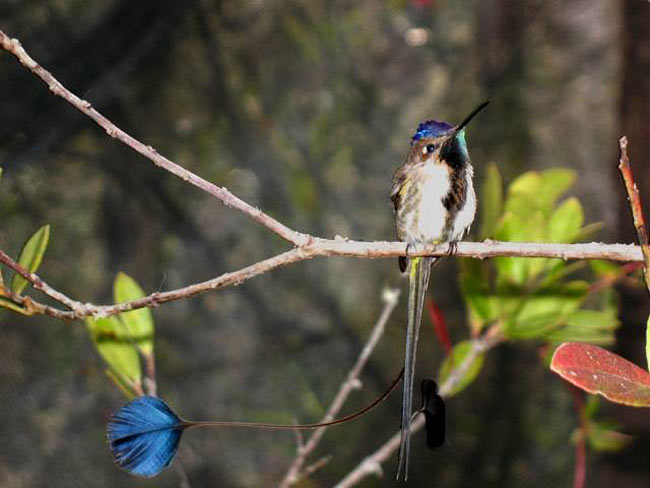Video Reveals Rare Hummingbird Courtship Display

When it’s time to compete for mates, males of one hummingbird species whip out their lengthy, “spatula-tipped” tails.
Scientists have released the first-ever video of the hummingbirds’ courtship displays, in which the males whirl their tails at incredible speeds to wow the ladies and avert other suitors who will hopefully turn tail.
"This is perhaps the most visually spectacular and specialized hummingbird in the world," said international nature videographer Greg Homel of Natural Elements Productions who shot the hummingbird video.
Called the Marvelous Spatuletail (Loddigesia mirabilis), the hummingbirds are unique in that they sport just four tail feathers. And the mini-males—just three inches long—make up for their size with tail feathers that extend to twice the length of their bodies. Two of the tail feathers are tipped with “spatulas” that glow an iridescent purple.
An estimated 250 to 1,000 of these hummingbirds remain in the wild and the population is declining, according to BirdLife International, a global partnership of non-governmental organizations focusing on bird conservation. Deforestation of the mountain slopes where the birds live and conversion of remaining forest habitat to cash crops are major threats.
"This is a truly magnificent display by a really spectacular bird. To lose this threatened species would be a tragedy," said Mike Parr, vice president of American Bird Conservancy. The conservancy and its partners made an agreement with a local Peruvian community in August 2006 to set aside a conservation easement in the northern part of that country.
- Video: Hummingbird Tales
- Images: Rare and Exotic Birds
- Male Birds Use ‘Wingman’ to Win Girl
Sign up for the Live Science daily newsletter now
Get the world’s most fascinating discoveries delivered straight to your inbox.
Jeanna Bryner is managing editor of Scientific American. Previously she was editor in chief of Live Science and, prior to that, an editor at Scholastic's Science World magazine. Bryner has an English degree from Salisbury University, a master's degree in biogeochemistry and environmental sciences from the University of Maryland and a graduate science journalism degree from New York University. She has worked as a biologist in Florida, where she monitored wetlands and did field surveys for endangered species, including the gorgeous Florida Scrub Jay. She also received an ocean sciences journalism fellowship from the Woods Hole Oceanographic Institution. She is a firm believer that science is for everyone and that just about everything can be viewed through the lens of science.










